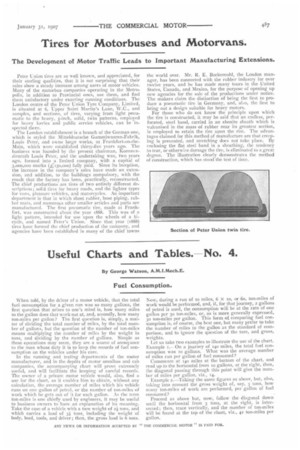Useful Charts and Tables. No. 4.
Page 19

If you've noticed an error in this article please click here to report it so we can fix it.
By George Watson, A.M.I.Mech.E.
Fuel Consumption.
When told, by the driver of a motor vehicle, that the total fuel consumption for a given run was so many gallons, the first question that arises to one's mind is, how many miles to the gallon does that work out at, and, secondly, how many ton-miles per gallon? The first question is, simply, a matter of dividing the total number of miles, by the total nutnber of gallons, but the question of the number of ton-miles means multiplying the number of miles by the weight in tons, and dividing by the number of gallons. Simple as these operations may seem, they are a source of annoyance to the man whose duty it is to keep the records of fuel consumption on the vehicles under -his care.
In the running and testing departments of the motor manufacturer, and in the depots of motor omnibus and cab companies, the accompanying chart will prove extremely useful, and will facilitate the keeping of careful records. The owner of a private motor vehicle would, also, find a use for the chart, as it enables him to obtain, without any calculation, the average number of miles which his vehicle runs on one gallon of petrol, or the number of ton-miles of work which he gets out of it for each gallon. As the term ton-miles is one chiefly used by engineers, it may be useful to business owners to haw. an explanation of its meaning. Take the case of a vehicle with a tare weight of zi tons, and which carries a load of 31 tons, including the weight of body, load, tools, and driver ; then, the gross load is 6 tons. Now, during a run of to miles, 6 x to, or 6o, ton-miles of work would be performed, and, if, for that journey, 2 gallons of petrol is used, the consumption will be at the rate of one gallon per 30 tononiles, or, as is more generally expressed, 30 ton-miles per gallon. This form ot comparing fuel consumption is, of course, the best one, but many prefer to take the number of miles to the gallon as the standard of comparison, and to ignore the question of the tare, and gross, weights. Let us take two examples to illustrate the use of the chart. Example I.—On a journey of 540 miles, the total fuel consumption was 30 gallons. What was the average number of miles run per gallonof fuel consumed?
Commence at 140 miles at the bottom of the chart, and read up to the horizontal from so gallons, at the right, then, the diagonal passing through this point will give the number of miles per gallon, viz., 14. Example 2.—Taking the same figures as above, but, also, taking into account the gross weight of, say, 3 tons, how many ton-miles of work are performed, per gallon of fuel consumed?
Proceed as above but, now, follow the diagonal down until the horizontal from 3 tons, at the right, is intersected; then, trace vertically, and the number of ton-miles will be found at the top of the chart, viz., 42 ton-miles per






















